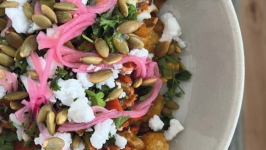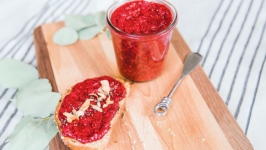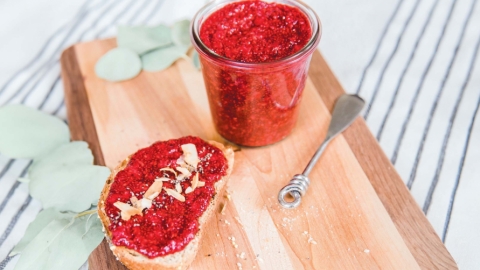Tap Into Your Inner Wild
PHOTOGRAPHY BY URIELL PROFT CARLSON AND RACHEL LEVIN
 “Your own inner wild is what makes you you and that’s an essential component of creating a nutrition strategy that will be sustainable for your life.” –Uriell Proft Carlson
“Your own inner wild is what makes you you and that’s an essential component of creating a nutrition strategy that will be sustainable for your life.” –Uriell Proft CarlsonI grew up on a small organic farm in East Dorset where food was a big part of our life. It wasn't until I moved to Colorado 16 years ago that I realized how fortunate I had been to grow up in my little Vermont bubble where homegrown food was in such abundance. I also realized very quickly how people talk about food and nutrition all the time! As a former professional mountain biker and competitive snowboarder, I found that conversations with friends were often spent wondering about food and asking questions about nutrition. I’ve always hoped that my career as a dietitian and nutritionist would be so much a part of my life that it doesn’t actually feel like “work.” Inner Wild Nutrition was founded to fill that goal in my life.
I believe that every one of us has our own inner wild. From our gut microbiome to the experiences our body stores to the things that light us up and the kinds of foods we love or hate. In a world that is inundated with polarizing nutrition rules trying to apply to everyone, it’s important that people recognize that what’s best for them will not be the exact same as everyone else and that just because it’s written in a book, made into a documentary, or comes with a meal plan doesn’t mean you’re supposed to fit it into your life. Your own inner wild is what makes you you and that’s an essential component of creating a nutrition strategy that will be sustainable for your life.
I now live (at 9,600 feet) in Breckenridge, Colorado with my amazing husband, Jeff, and our 2-year-old son, Roland. We love living in the Colorado mountains, but as a Vermont farm kid, I recognize the stark limitations of our short growing season. We always look forward to visits back to my family farm and homestead so that we can show Roland what it’s like to know exactly where so much of our food comes from.
As a dietitian who bases my work on each of my individual client’s needs, this task of writing a piece that applies to thousands of readers suddenly gets a bit complicated. Upon some reflection, I have found that there are a handful of practices that I have seen benefit every single client who works through my Fuel Your Potential Program, so that’s what I want to share with you. From here, take what you need from this. Know that consistency is always more sustainable than perfection and that these guidelines are means to be adapted to your needs, your food preferences, and your life!
One of the most important aspects of long-term nutrition change is figuring out what’s actually going on. Instead of simply riding the waves of your day and allowing what, when, and how you eat to be an afterthought, I see over and over again that you all need to have awareness about what your current baseline is. From there, you can adjust. With this awareness, you’ll figure out if you’re eating intentionally or reactively.
REACTIVE VS. INTENTIONAL EATING
Eating reactively can often feel like you’re on a roller-coaster all day, while at the mercy of your schedule and which type of food happens to be in front of you. You go long periods of time without eating, only to overeat by the time you do eat. You eat without thought or while multitasking, often resorting to high-carb foods that only spike your blood sugar and then let it crash and leave you hungry again 45 minutes later.
Intentional eating means you’re eating throughout the day to meet your needs in the moment. You’ve put some advance thought into your eating plan. You have a backup snack in the event that you suddenly find yourself hungry, yet a couple of hours out from being able to have a meal. You get a balance of carbs for energy and protein for hunger prevention, rather than just one piece of the puzzle. You have a level of knowledge that allows you to build balanced meals and snacks so you can meet your needs consistently. This also means you’re eating enough. Your calorie needs may be hard to meet with the busy life many of us lead (especially if you have an additional layer of needs as an athlete or another highly active profession or pursuit), so this is where intentional eating becomes very important. We’re not just talking numbers here: intentional eating leads to level energy, no afternoon slumps, less overeating and feeling crummy about it, and the ability to do the active things you love, without having to struggle through.
When you get this dialed, you’ll have more brain space to focus on more important things in your life (rather than fret about what your next meal will be!). You’ll enjoy more consistent energy without the lows or overcompensation. And, if your day doesn’t go to plan and you feel like you’re dragging come dinnertime, you can look back and recognize why. This is really important. No more just thinking, I’ll do better tomorrow, or I’m just always tired.
“Your calorie needs may be hard to meet with the busy life many of us lead (especially if you have an additional layer of needs as an athlete or another highly active profession or pursuit), so this is where intentional eating becomes very important.” –Uriell Proft Carlson
STEP 1: BUILD A BALANCED MEAL
To be intentional about eating, one of the first things you can do is build balanced meals. This doesn’t mean you have to be meal prepping every weekend or following recipes every day. Instead, it means you have to know what you want to include in a meal and thus put on your plate. This is the formula I use: protein + plants + complex carbohydrate + healthy fat. And here’s why:
PROTEIN
Protein is the base of any balanced meal. Protein keeps you full between meals and snacks, supports muscle recovery, and can even support immunity.
PLANTS (VEGGIES & FRUIT)
Not only do plants include fiber, which is great for gut health, digestion, and satiety, but they’re also your biggest nutritional bang for your buck because of the antioxidants, vitamins, minerals, and all the goodness found in plant foods.
COMPLEX CARBS
Carbs are the main source of fuel for your brain, so if you struggle with brain fog or have trouble focusing, especially if you hit that afternoon slump at work, carbs are your friends. Complex carbs are vital for active folks, providing longer-term energy.
HEALTHY FATS
This one is often overlooked, but fat makes up 60 percent of our brains, making it essential for brain health. Fats are also another satiety macronutrient. They digest slowly, just like protein, and thus keep you feeling full for longer.
In all, snacks should include a source of protein and a complex carbohydrate so that you get that hunger prevention you need plus a bit of an energy boost from the carbohydrate.
STEP 2: PLAN FOR YOUR SUCCESS & STOCK YOUR KITCHEN
If the ingredients are at your fingertips, you’ll be more likely to create a balanced meal—make it easy on yourself. This is all part of intentional rather than reactive eating. The key is learning to stock a balance of shelf-stable pantry items and perishables so that you always have what you need on hand. Check out the Meal-Building Guidelines chart for quick and easy go-to items.
A lot of times, I’m not even following a recipe. Instead I’m thinking through this balanced meal formula in my head: protein + plants + complex carbohydrate + healthy fat. Now, let’s put this into action.
First, I figure out my protein option. From there, I take stock of what I have on hand for plants. What’s going to go with this protein? Then, I find a carbohydrate. This is usually the easiest because many carbs are more shelf-stable than, say, your protein sources. From there, I make sure I’ve got a healthy fat. This could be something as simple as the olive oil I use to cook my veggies or it might be that avocado on my counter.
STEP 3: FIT IN HEALTHY, EASY SNACKS
The reality is that most of us need more than three meals per day. This is where snacking comes in to play. If you’re wondering if and when you should be snacking, here are some considerations:
- If you go so long between meals that you tend to overeat, add a snack in between.
- If you don’t have the time or capacity for a full meal, insert a snack.
- If your calorie needs are high and you can’t meet them with three meals, snacks will help.
However, not all snacks are created equal. A piece of fruit sounds great, but that’s only a complex carb providing you with energy and you’ll likely be hungry again in 45 minutes. To get some hunger prevention, you want to include protein. So, add some Greek yogurt or a handful of nuts to that fruit or put apple slices on a piece of whole grain toast with ricotta and honey. You can even open some tinned fish and load it onto whole grain crackers with a squeeze of lemon juice. In all, snacks should include a source of protein and a complex carbohydrate so that you get that hunger prevention you need plus a bit of an energy boost from the carbohydrate.
One of my favorite snack vessels is a piece of sprouted whole grain toast. I top it with anything from tahini and honey to a fried egg and avocado or my quick chia seed jam.
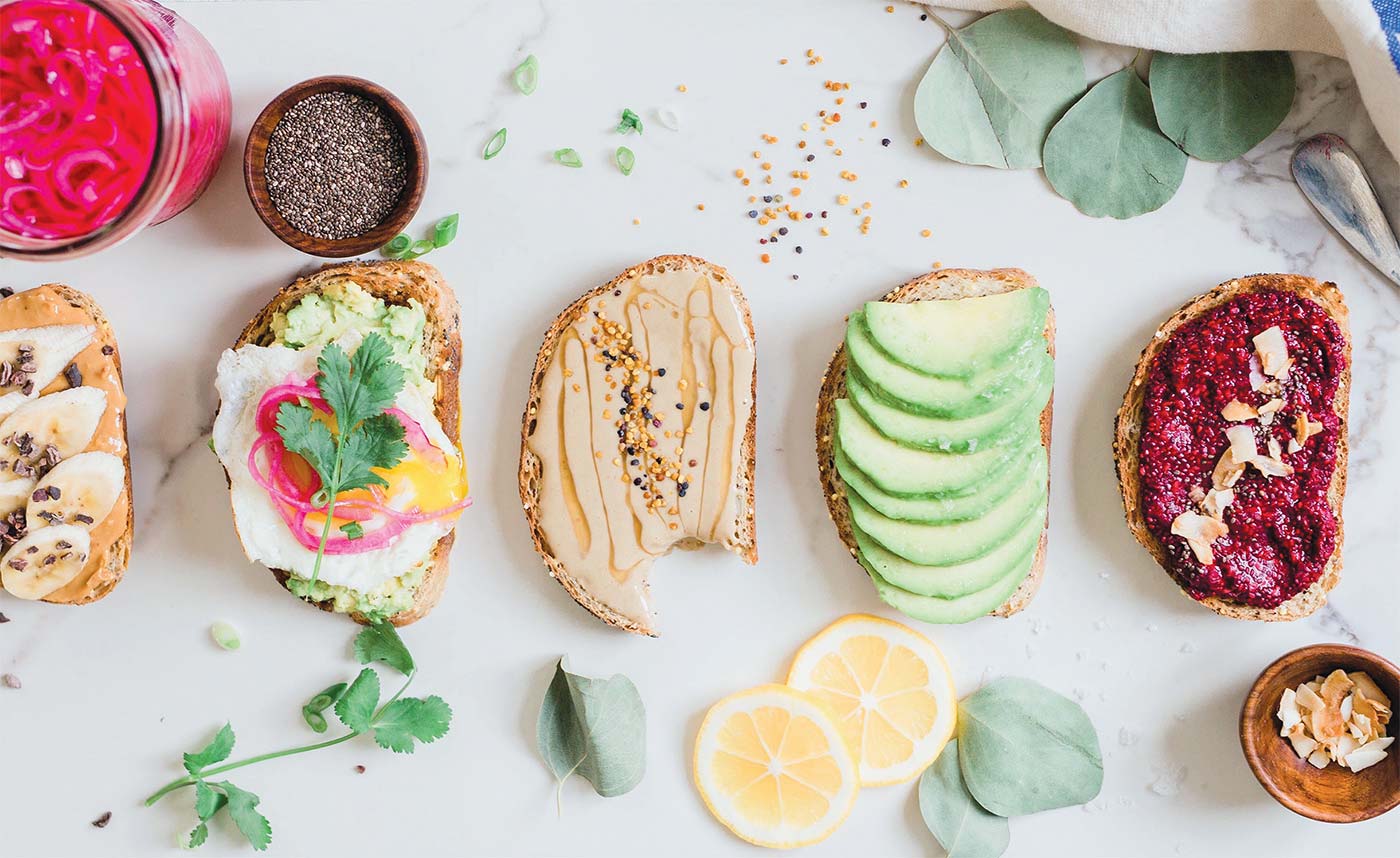
Toast on! peanut butter/banana/cacao nibs; avocado/egg/pickled red onion; tahini/honey/bee pollen; avocado/lemon juice/salt; chia seed jam with toasted coconut flakes
STEP 4: MAKE THIS WORK FOR YOU
Now, as I always say to my clients, start small. If you decide you need to start a new approach to nutrition tomorrow and try to do everything at once, you’re going to burn out. Instead, pick from this article one actionable that sounds the most exciting or needed for you. Then, come back in a few weeks and add on another layer. As you build, you’re creating a solid foundation that supports further change. Always ask yourself, “Can I do this at least 80 percent of the time for the long run?” If not, you may have to cut back. Chances are that if you come back to that same question in a few weeks, your answer will be different. You don’t get to take a rest week from eating, and we should all be eating every day, multiple times per day (something I want to recognize as a great privilege).
Here’s the thing: You have at least five eating opportunities throughout your day. Even if one or two of those aren’t ideal or don’t go as planned, you still have the chance to make good choices with the majority of your eating opportunities—that is what matters most! Be consistent and don’t stress about perfection for every meal and snack. Remember that small changes can add up and make a big difference when you give them time and stay consistent. As with most things in life, and especially with nutrition, consistency is always better than perfection.
IG @uri_carlson
HEALTHY & EASY SNACK SUGGESTIONS
Mixed beans tossed with olive oil, citrus, parsley, cracked pepper, and salt with whole-grain crackers
Smoked salmon, sliced cucumbers, cream cheese on toast or crackers with a squeeze of lemon juice, capers, and salt
Sprouted whole-grain bread with ricotta, apple slices, and honey
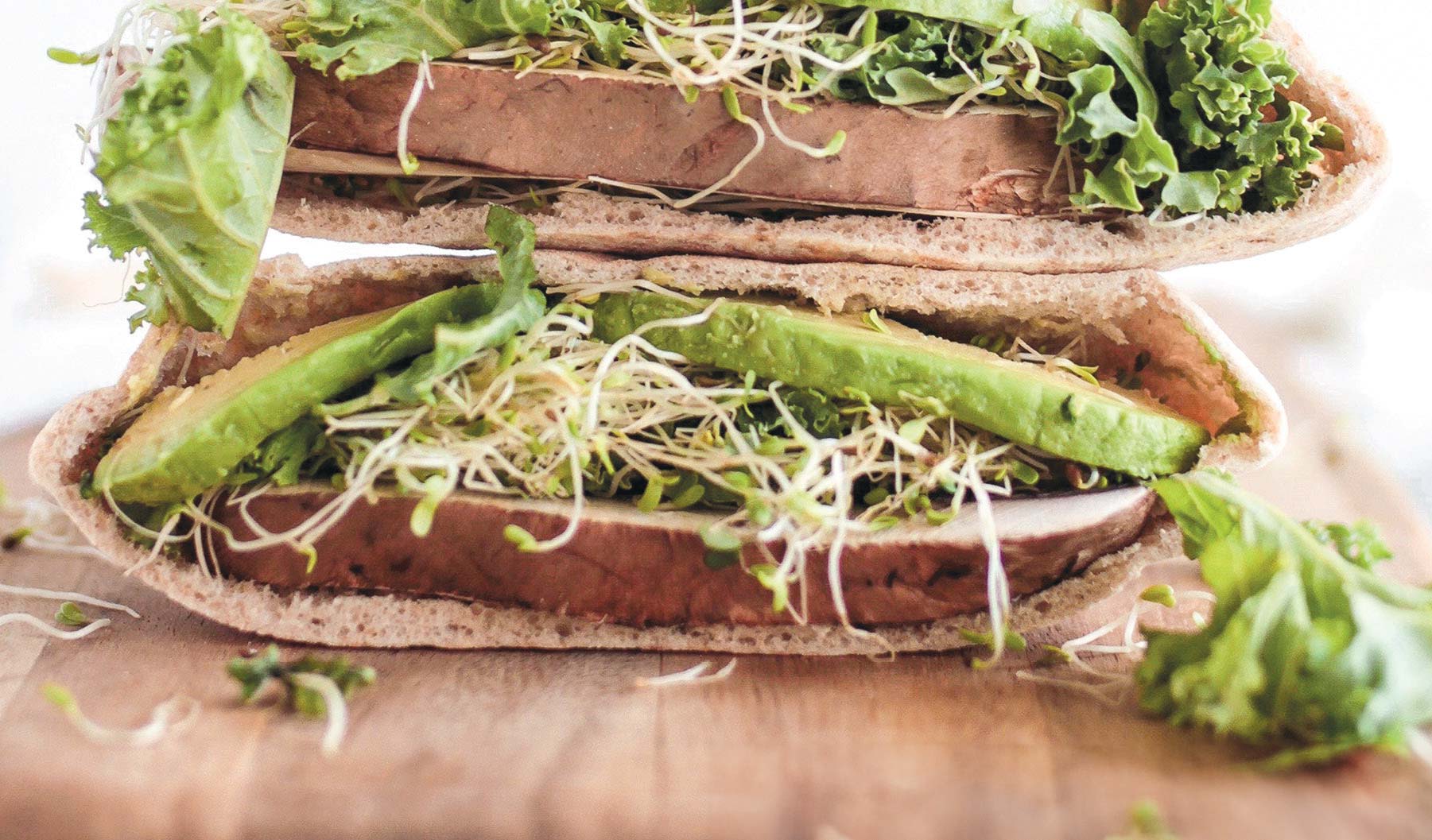
INNER WILD NUTRITION
Meal Building Guidelines
A SOURCE OF PROTEIN
+
VEGETABLES - AT LEAST 2
(GET AS MUCH COLOR + VARIETY AS POSSIBLE)
+ COMPLEX CARBOHYDRATE (especially if training/active)
+ CHECK FOR HEALTHY FATS
= A COMPLETE, BALANCED MEAL
START HERE: PROTEINS
- Fish (salmon, tuna fish in water, cod)
- Lean + grass fed beef
- Chicken breast + ground turkey
- Beans + lentils
- Nuts + seeds (be mindful of fat content)
- Eggs
- Milk + Greek yogurt + cottage cheese (be mindful of fat content)
- Organic Soy/Tofu
- Collagen
- Protein Powders
- Antibiotic/hormone free deli meat
- Banza Chickpea Pasta
THEN, ADD VEGETABLES
- Greens (lettuces, spinach, arugula, etc.)
- Peppers
- Summer squash, zucchini
- Radish
- Cucumber
- Carrots
- Broccoli, cauliflower, brussel sprouts
- Cabbage
- Celery
- ALL THE PLANTS!
COMPLEX CARBOHYDRATES COME 3rd
- Whole grain + sprouted bread (Ezekiel, Dave's Killer Bread)
- Brown rice
- Quinoa (also great protein)
- Peas, corn
- Potatoes (sweet and white)
- Fruit
- Oatmeal + whole grain cereals
- Seedy crackers (Mary's Gone Crackers)
LAST, CHECK FOR HEALTHY FATS
- Nuts + seeds
- Olive Oil
- Olives
- Avocado
- Coconut oil
- Sesame oil
- Grapeseed oil
- Peanut oil
- Fish


